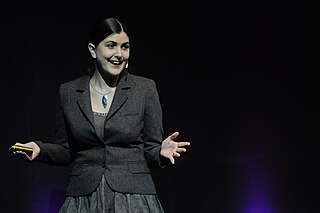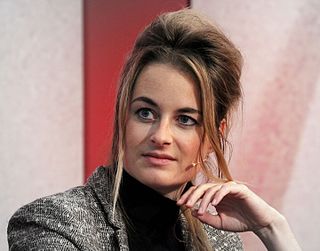
Peter Weibel was an Austrian post-conceptual artist, curator, and new media theoretician. He started out in 1964 as a visual poet, then later moved from the page to the screen within the sense of post-structuralist methodology. His work includes virtual reality and other digital art forms. From 1999 he was the director of the ZKM Center for Art and Media Karlsruhe.
eSeL is an art platform in Vienna, Austria. Founded 1998 by Lorenz Seidler, it provides a weekly newsletter "eSeL Mehl", various mailing lists, a photo-archive and an event-database. The label "eSeL" is also serving as a nickname for the artist Lorenz Seidler, who also is initiating, curating and conducting various art projects. eSeL's offices are located at Museumsquartier in Vienna.

Quarxs was one of the earliest computer-animated series, predating ReBoot, and the first one produced in HD. It was aired between 1990 and 1993.

Honor Harger is a curator and artist from New Zealand. Harger has a particular interest in artistic uses of new technologies. She is currently the executive director of the ArtScience Museum in Singapore.

Nettime is an internet mailing list proposed in 1995 by Geert Lovink and Pit Schultz at the second meeting of the "Medien Zentral Kommittee" during the Venice Biennale. Since 1998, Ted Byfield and Felix Stalder have moderated the main list, coordinated moderation of other lists in the nettime "family," and maintained the site as their nexus.

Martina Schettina is an Austrian artist. The main part of her work is Mathematical art.

Rolling Stars and Planets is an Austrian visual art project of exhibitions and performances with sphere objects. The project mastered by Elisabeth Ledersberger-Lehoczky is joined by about 25 artists who come mostly from Austria, but also from Hungary and Germany.

The Atelierhaus Salzamt, which translates to "Studio House Salt Authority," is a cultural institution founded in 2009 in Linz, Austria. Its core mission is to promote and enrich international exchange programs in the visual arts field. The facility serves various roles, acting as an art gallery, offering accommodation for artists, and providing studio space to both local and international artists.

Marcel·lí Antúnez Roca is an artist from Spain who uses digital technologies in the fields of mechatronic performance and installation art.
gold extra is an artistic collective from Salzburg, Austria, that was founded in 1998. The group's work is focused on various disciplines such as performance, theatre, game design and visual art.
Emilia Telese is an Italian artist whose practice includes performance, visual, site-specific and video art, interactive and body-responsive technology, installation, literature and public art. She lives and works between Brighton, UK, Foggia, Italy, and Reykjavik, Iceland. Telese graduated in 1996 with a BA (Honours) in painting from the Fine Arts Academy, Florence, focusing on 14th-century techniques, Arte Povera and political performance. In 1997 she studied acid-based printmaking techniques at the University of Brighton, where she continues to lecture. In addition she lectures at other institutions in the UK and internationally, specialising in the relationship between art, economics and professional practice. Her work Life Begins at Land's End (2013) was part of Rebirth Day, a concept organised by Michelangelo Pistoletto. Pistoletto named her a Third Paradise Ambassador, which is a small group of people chosen by him to embody the spirit of his Third Paradise concept. Her videos, along with works by other artists, were shown at the Musee du Louvre in Paris. In 2015 her exhibition Modern Women was featured at Airspace Gallery in Stoke-on-Trent, with artist Binita Walia.
Alba D'Urbano is a textile and video artist.

Ars Electronica Linz GmbH is an Austrian cultural, educational and scientific institute active in the field of new media art, founded in Linz in 1979. It is based at the Ars Electronica Center (AEC), which houses the Museum of the Future, in the city of Linz. Ars Electronica's activities focus on the interlinkages between art, technology and society. It runs an annual festival, and manages a multidisciplinary media arts R&D facility known as the Futurelab. It also confers the Prix Ars Electronica awards.
Annette Louise Barbier was an American artist and educator. She worked with video art, net art, installation art, interactive performance, and emerging and experimental technologies since the 1970s. Themes in her work address "issues of home, defined locally as domesticity and more broadly as the ways in which we relate to our environment." An early work, "Home Invasion [1995]," incorporating critical dialogue and audio, is accessible from Leonardo. "Domestic space—formerly inviolable—is increasingly disrupted by electronic communication of all sorts, including radio, TV, email and the telephone." She was Chicago-based.
Kathy Rae Huffman is an American curator, writer, producer, researcher, lecturer and expert for video and media art. Since the early 1980s, Huffman is said to have helped establish video and new media art, online and interactive art, installation and performance art in the visual arts world. She has curated, written about, and coordinated events for numerous international art institutes, consulted and juried for festivals and alternative arts organisations. Huffman not only introduced video and digital computer art to museum exhibitions, she also pioneered tirelessly to bring television channels and video artists together, in order to show video artworks on TV. From the early 1990s until 2014, Huffman was based in Europe, and embraced early net art and interactive online environments, a curatorial practice that continues. In 1997, she co-founded the Faces mailing list and online community for women working with art, gender and technology. Till today, Huffman is working in the US, in Canada and in Europe.

Günther Selichar is an Austrian visual artist.
Faces is an international online community of women who share an interest in digital media arts. They communicate via an email list and organize events both online and off. Founded in 1997, this informal network includes activists, artists, critics, theoreticians, technicians, journalists, researchers, programmers, networkers, web designers, and educators.
Wolfgang Paul Georgsdorf is an Austrian media artist, director, sculptor, musician, author, researcher, and inventor based in Berlin. He was founder and spokesman of Opal-so-nicht which resulted in a successful case against Gazprom and BASF in Dahme-Heideseen Nature Park, Brandenburg, Germany.

Teresa Präauer is an Austrian writer and visual artist.












